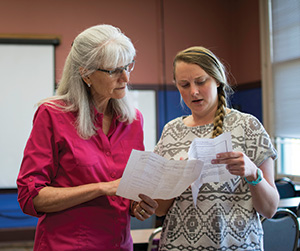
In the past several years, postgraduate educational institutions in the U.S. have been honing in on the importance of revising curricula to address the changing learning styles of a new generation of students.
NCNM, known for its high standards in didactic and clinical training, is embarking on its first top-to-bottom curricula overhaul after a long period of planning. With an eye toward best educational practices, the focus is on integration, communication across medical disciplines, and the creation of a more dynamic model of instruction that engages students whose learning styles require more interaction.
New Curricula Will Emphasize Hands-On, Cross-Discipline Learning
In the past several years, postgraduate educational institutions in the U.S. have been honing in on the importance of revising curricula to address the changing learning styles of a new generation of students. Dr. Kimberly Windstar and NCNM, known for its high standards in didactic and clinical training, is embarking on its first top-to-bottom curricula overhaul after a long period of planning. With an eye toward best educational practices, the focus is on integration, communication across medical disciplines, and the creation of a more dynamic model of instruction that engages students whose learning styles require more interaction.
The idea is to liven up classes with less seat time and more hands-on experiences directly related to what students will be doing after graduation, said Dr. Denise Dallmann (’03).
Dallmann, who was appointed full-time director of curricula reform in 2013, is focusing first on naturopathic education and working closely with Dr. Melanie Henriksen (’05), dean of the School of Naturopathic Medicine. In turn, the pair have been working with faculty, surveying students and alumni, and examining what other schools are doing
“The program needed to be refreshed and reviewed,” said Dallmann, who noted that the process “is not just an edit of what we do, but an examination from the bottom up to create something brand new.”
Recommendations from the accreditation process were one factor in the effort, Dallmann added. Also, notes Henriksen, “Medical education is changing pretty dramatically. A huge number of schools are looking at or are currently involved in curriculum reform. We felt we need to do the same to assure that we are providing the best education possible.”
Henriksen noted that the NCNM faculty are a key catalyst for the changes. “The faculty are very, very enthusiastic. They have been asking for this for a long time.”
Longtime naturopathic medicine professor Dr. Nancy Scarlett (’97) agrees. “We need to continue to improve the content and delivery of our naturopathic program.” She said faculty members are looking forward to weeding out redundant instruction, adding depth wherever necessary and addressing new topics most relevant to today’s students.
Perhaps most importantly, Scarlett said, the new curriculum will emphasize integration across disciplines and hands-on application of the knowledge right away. “We’ve been teaching our ND students theory for their first two years in school, which doesn’t get put into context until they get into clinical training, so they don’t get to apply what they’ve learned until later. We’re trying to deliver the material in a more dynamic, integrated fashion—how the body works, what goes awry and what can be done about it at each stage of instruction.”
Also key, said Scarlett, is a better understanding of what skills and professional attributes students will need in the field. “It’s necessary to figure out what our outcome graduate looks like, what skills are central, what type of demeanor and social/cultural skills are needed to be a doctor.”
All agree that the new curriculum will take into account that today’s college students are technically savvy and less interested in the traditional lecture format that has been a central part of education at NCNM for past generations. Whenever possible, lectures will be limited, allowing for small group interactions—in short, more doing than sitting. The result will be reflective of the newest trends in higher education and a naturopathic curriculum that inspires creativity in teachers as they deliver their instruction, said Scarlett.
So, after months of meetings across all NCNM constituent groups, curriculum reformers have found broad consensus of the following goals:
- Reduce seat time for students
- Integrate more active learning strategies
- Increase opportunities for synthesis of information across the curriculum
- Determine the best schedule/ structure to meet program outcomes
- Increase clinical hours and patient contacts
- Increase inter-professionalism and cultural competency skills
- Increase simulation and OSCE (Objective Standardized Clinical Evaluation) experiences
Still to come are some nuts and bolts related to class structures and content delivery. If approved by accreditors, the whole package is scheduled to roll out for classes in fall 2015.
“We will do all of those things,” said Henriksen, “this is our opportunity to really step up.”